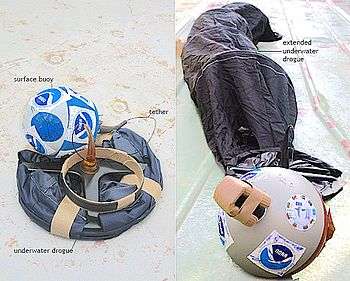Drifter (floating device)

A drifter (not to be confused with a float) is an oceanographic device floating on the surface to investigate ocean currents and other parameters like temperature or salinity.[1] Modern drifters are typically tracked by satellite,[2] often GPS. They are sometimes called Lagrangian drifters since the location of the measurements they make moves with the flow. A major user of drifters is the Global Drifter Program.

Construction principle
The major components of a drifter include surface floats for buoyancy, underwater drogues to ensure the drifter follows the movements of the water and is unaffected by wind, instruments (e.g., data collecting instruments, transmitters to transmit the collected data, and GPS devices), and waterproof containers for instruments.[3][4] Drifters are a technological evolution of ocean current analysis historically performed through drift bottle experiments, which in turn were built on the principle of a message in a bottle.[5]
Applications
Physical oceanography
Drifters provide real-time information about ocean circulation. They make more accurate and frequent observations of surface current velocity than is possible from remote sensing measurements.

Biological oceanography
Drifters are frequently used to collect information on biological oceanography, such as transport of organisms.
Types
- CODE drifter[7]
- SVP drifter
See also
- Ice rafting, another means to investigate ocean circulation
- Swallow float
- Pearn P. Niiler – responsible for many developments in drifter technology and establishment of the Global Drifter Program
- Friendly Floatees
References
- ↑ "What's a drifter?"
- ↑ Global Drifter Program
- ↑ "Drifters"
- ↑ "Dissect a Drifter"
- ↑ "NWFSC's Own Message in a Bottle: Ocean Drifters and Tiny Tags Have Been Telling Stories for Decades". NOAA's NWFSC. 2013. Archived from the original on July 24, 2016.
- ↑ "Doing Their Part: Drifter Buoys Provide Ground Truth for Climate Data". NOAA (climate.gov). May 16, 2013. Archived from the original on December 19, 2015.
- ↑ "Nearshore Circulation in the Bering Sea"